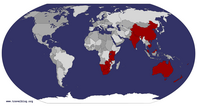Back on the mainland, we drive through Tanzania to our next destination - Malawi, one of the poorest countries in Africa. Our main port of call is Lake Malawi, the vast body of water which accounts for 30% of the country’s land area. Driving into Malawi, we immediately notice a difference to the other African nations to the north - most houses are traditional mud and straw huts, and there are few large settlements. After passing through stunning, rugged scenery, we stop first at Chitimba, a campsite on the shores of Lake Malawi, before heading further south to Kande Beach, where we’re to spend 3 nights. Compared to the golden but bare sands of Zanzibar, Kande Beach has much more character, but our stay there quickly comes to be characterised by the people of Malawi rather
... read more


































